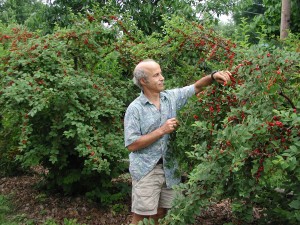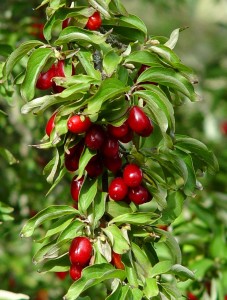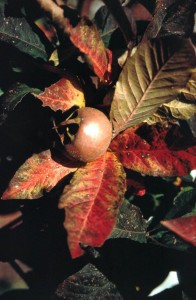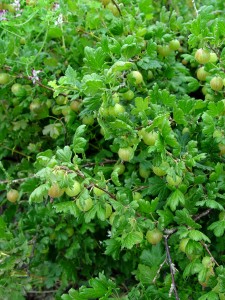Fruits You Can Actually Grow at Home
January 11th, 2012
We may not be ready for gumi bushes and shipova trees, but Lee Reich thinks there’s little excuse why more people aren’t growing pawpaws, persimmons and medlars.
Those are all fruits, by the way. Tasty and nutritious ones, too. And very easy to grow with little pruning and no spraying.
Yet most people have never even heard of those plants, much less grown or eaten them.
That’s because we tend to know only the fruits that are sold in supermarkets, and those are species chosen more by how commercially viable, shippable and shelf-stable they are – not by how good they taste.
Reich is a kind of new-age Johnny Appleseed, attempting to make America more fruitful by spreading the word about uncommon fruits rather than by spreading seeds with a pot on his head.
This former Cornell University fruit researcher and soil scientist has written a book called “Uncommon Fruits for Every Garden” (Timber Press, $24.95, 2004).
The gist of it is that American gardeners are pretty much out of the fruit loop. Of all the categories of plants we grow, fruit has become the forbidden one.
Reich thinks that’s because we’ve been jaded by our not-so-successful attempts at growing the more familiar crops, such as apples.
“If you want to pick the one fruit that’s the hardest to grow, it’d be apples,” he says, ticking off the pruning demands and long list of pests and diseases that apple-growers have to deal with.
Yet that’s the first fruit crop gardeners here tend to try.
Those beaten down on the apple front also tend to try cherries, peaches, apricots, grapes and strawberries – only to find the going isn’t much easier.
Cherries and grapes are quick to rot without regular sprays. Apricots get hammered most years by late frost. Birds, weeds and rodents are obstacles in the strawberry patch.
And peaches? Considering frost, rot, leaf-curl disease, Japanese beetles and the recent brush with plum pox disease, it’s a miracle that anyone actually produces a ripe peach. I cut down my peach trees after overcoming all of those, only to find groundhogs up in the trees eating almost-ripe fruits right off the branches.
Reich says we’d fare much better by seeking out things we may not know but that are no tougher to grow than a basic landscape shrub.
“A lot of these fruits, the only way you’re going to get to eat them is to grow them yourself because they’re not available in supermarkets,” he says. “I think people are interested lately in more exotic stuff.”
Home gardeners have the advantage of not having to worry about whether a particular fruit crop can be picked by machine or whether the fruits all ripen at the same time to maximize labor efficiency.
We don’t have to worry about whether a fruit bruises while shipping.
We don’t have to care that it’s a bit gnarly looking instead of bright, red and shiny.
We don’t have to worry about whether it’s going to start going bad just three or four days off the vine.
Home gardeners can pick fruit at the peak of ripeness and eat it that day. That’s one reason why home-grown fruits taste better and are packed with more nutrition than even the exact same variety grown for retail.
“I especially like dessert fruits – the kind of things that you can walk down the garden and eat out of hand,” says Reich.
He also doesn’t like spraying or otherwise having to baby plants to coax the fruity reward out of them.
In other words, he likes the “kind of plants that you stick in the ground, water and weed for a couple of years, then pick fruit for 50 years.”
There are plenty of choices like that. Reich’s New York yard – and book – is filled with them.
Reich points out that you don’t have to grow fruits in orchards. Most of his uncommon suggestions look good enough to fit right into the landscape.
One of his favorite examples is how he replaced a prune-happy forsythia hedge with a line of Nanking cherries (Prunus tomentosa).
This no-spray shrubby member of the cherry family tops out at 10 feet (less with a single annual pruning), produces pink flowers in spring and then is loaded with small, red, sweet-tart fruits in June.
“The fruit doesn’t keep well, and birds and squirrels like it, too,” says Reich, “but it fruits so heavily that there’s plenty left for you. And it makes a great hedge.”
Reich says the Cornelian cherry dogwood (Cornus mas) makes a great small specimen tree, producing tart red fruits almost as a bonus. It blooms yellow in early spring before the leaves come out, and it offers bright fall foliage, too.
Another low-care small tree is the medlar (Mespilus germanica), which was popular as far back as the Middle Ages. It blooms white in late spring and then produces golfball-sized, apple-like fruits that have little spikes on the bottom.
“The fruit is not all that pretty,” Reich says. “But it tastes like a rich apple sauce with a little wine and cinnamon mixed in.”
And it needs no spraying.
Two other slightly larger and no-spray fruiting trees that Reich likes a lot are the American persimmon (Diospyros virginiana) – “It tastes like apricots soaked in water with a little honey and spices” – and the native pawpaw tree (Asimina triloba) – “The kidney-shaped fruits taste like banana with a hint of avocado, mango and custard.”
See below for 10 more choices that Reich believes are worthy of greater use.
Then hope the neighborhood Japanese beetles and groundhogs don’t develop the same new tastes that you do…
* Ten more uncommon but tasty and low-care fruits author Lee Reich suggests for central-Pennsylvania gardens:
1.) Gooseberry (Ribes). Multi-stemmed shrub with grape-sized tart to semi-sweet fruits. Excellent in pies.
2.) Red or white currants (Ribes). Multi-stemmed shrub with clusters of pea-sized red or white tart fruits, best used for jelly.
3.) Alpine strawberry (Fragaria vesca). A short, compact perennial that produces small red or white strawberries all summer. Also makes a nice edging plant.
4.) Lowbush blueberry (Vaccinium angustifolium). A low, woody trailer that produces small blueberries in summer. Makes a nice groundcover and has great fall foliage.
5.) Lingonberry (Vaccinium vitis-idaea). A compact bush with glossy evergreen leaves and red fruits that are similar to cranberries.
6.) Hardy kiwi (Actinidia arguta or kolomikta). An attractive woody vine that produces hanging white flowers followed by sweet, smooth, grape-sized fruits (not the egg-shaped fuzzy ones like in the grocery store).
7.) Serviceberry (Amelanchier). Also known as “juneberry,” a small tree that flowers white and produces small blueberry-like fruits that taste more like almond-tinged cherries.
8.) Gumi (Elaeagnus multiflora). Much better known in the Orient, this 6- to 10-foot flowering shrub gets small, tart, cherry-like fruits in July. Also known as the “cherry silverberry.”
9.) Shipova (x Sorboyrus auricularis). A small tree that’s a cross between mountain ash and pear. Flowers white with fruits similar in taste and texture to pear.
10.) Clove currant (Ribes odoratum). Midwestern native shrub that blooms yellow in early spring and gets tart black fruits in early summer.
* Where to buy?
Local garden centers carry some varieties of uncommon fruits. For those you can’t find but want to try, here are a few mail-order sources:
* Edible Landscaping Nursery, Afton, Va. 800-524-4156. www.eat-it.com.
* Hidden Springs Nursery, Cookeville, Tenn. 931-268-2592. www.hiddenspringsnursery.com.
* Oikos Tree Crops, Kalamazoo, Miss. 269-624-6233. www.oikostreecrops.com.
* One Green World, Molalla, Ore. 877-353-4028. www.onegreenworld.com.
* Raintree Nursery, Morton, Wash. 360-496-6400. www.raintreenursery.com.
* Saint Lawrence Nurseries, Potsdam, N.Y. 315-265-6739. www.sln.potsdam.ny.us.











